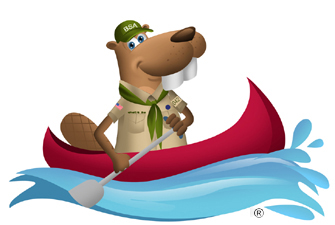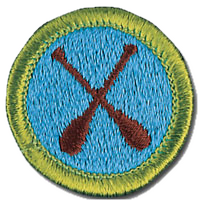Canoeing


Resources
- Canoeing Merit Badge Pamphlet
- Canoeing Merit Badge Class Preparation Page
- Canoeing Merit Badge Workbook
- Scoutmaster Bucky's Merit Badge Advancement Quick Reference
- Scoutmaster Bucky's Acknowledgement Form
Related
Canoeing Requirements
Current Scouts BSA requirements
as of December 6, 2025
as of December 6, 2025
1.
Do the following:
a.
Review with your counselor the most likely hazards you may encounter
while participating in canoeing activities and what you should do to
anticipate, help prevent, mitigate, and respond to these hazards.
b.
Review prevention, symptoms, and first-aid treatment for the following
injuries or illnesses that could occur while canoeing: blisters,
cold-water shock and hypothermia, dehydration, heat-related illnesses,
sunburn, sprains, and strains.
c.
Discuss the Scouting America Safety Afloat policy. Tell how it applies
to canoeing activities.
2.
Before doing the following requirements, successfully complete the Scouting
America swimmer test: Jump feetfirst into water over the head in depth.
Level off and swim 75 yards in a strong manner using one or more of the
following strokes: sidestroke, breaststroke, trudgen, or crawl; then swim
25 yards using an easy, resting backstroke. The 100 yards must be completed
in one swim without stops and must include at least one sharp turn. After
completing the swim, rest by floating.
3.
Do the following:
a.
Name and point out the major parts of a canoe.
b.
Describe how the length and shape of a canoe affect its performance.
4.
Do the following:
a.
Name and point out the parts of a paddle.
b.
Demonstrate how to correctly size a paddle for a paddler in a sitting
position and a kneeling position.
5.
Do the following:
a.
Review with your counselor the characteristics of life jackets most
appropriate for canoeing and tell why a life jacket must always be worn
while paddling.
b.
Demonstrate how to select and properly fit the correct size life
jacket.
c.
Review the importance of safety and rescue equipment such as a sound
signal device, extra paddle, sponge, bailer, bilge pump, rescue sling,
ropes, throw bag.
6.
Review with your counselor the general care and maintenance of canoes,
paddles, and other canoeing equipment.
7.
With a companion, use a properly equipped canoe to demonstrate the
following:
a.
Safely carry and launch the canoe from a dock or shore (both, if
possible).
b.
Safely land the canoe on a dock or shore (both, if possible) and return
it to its proper storage location.
c.
Demonstrate kneeling and sitting positions in a canoe and explain the
proper use for each position.
d.
Change places while afloat in the canoe.
8.
With a companion, use a properly equipped canoe to demonstrate the
following:
a.
Safely exit the canoe in deep water without losing contact with the
canoe. Reenter the canoe with the assistance of the other paddler
without capsizing the boat.
b.
Safely perform a controlled capsize of the canoe and demonstrate how
staying with a capsized canoe will support both paddlers.
c.
Swim, tow, or push a swamped canoe 50 feet to shallow water. In the
shallow water, empty the swamped canoe and reenter it.
d.
In deep water, rescue a swamped canoe and its paddlers. After checking
that those in the water do not need immediate assistance, empty the
swamped canoe and help the paddlers safely reenter their boat without
capsizing.
e.
Perform a canoe rescue of a conscious swimmer.
f.
Using a rescue (throw) bag from shore, lay the line within 3 feet of a
conscious swimmer 30 feet away. Show how to repack the bag when done.
9.
With a companion, using a properly equipped canoe to demonstrate the
following tandem maneuvers while paddling in unison on opposite sides and
without changing sides. Each paddler must demonstrate these maneuvers in
both the bow and stern and on both sides of the canoe while maintaining
trim and balance of the canoe:
a.
Pivot (spin) the canoe 180° (half circle) to the right from a
stationary position, stop, and return to the starting position by
pivoting to the left using draw and pushaway strokes or using forward
and reverse sweeps staying within 2 boat lengths of the starting
position.
b.
Move a canoe sideways (abeam) in one direction for 10 feet and then
return to the starting position using the draw and pushaway strokes.
c.
While in forward motion, stop the canoe within two boat lengths using
the backstroke.
d.
While in the stern position and without assistance from the bow
paddler, paddle in a straight line 15-20 boat lengths using an
appropriate steering stroke, e.g., the J-stroke or thumb-down rudder
stroke with or without a stern pry.
e.
Move the canoe in a straight line 15-20 boat lengths with the bow
paddler using as necessary the forward stroke, draw stroke or forward
sweep and the stern paddler using an appropriate steering stroke, e.g.,
the J-stroke or thumb-down rudder stroke with or without a stern pry.
f.
While maintaining forward motion, turn the canoe 90° in an arc to the
right in 5-10 boat lengths with the bow paddler using as necessary
either the draw stroke or forward sweep and the stern paddler using
only the forward stroke. Repeat the maneuver turning the canoe 90° to
the left.
g.
Move the canoe backwards in a straight line 3-4 boat lengths using as
necessary the back stroke, reverse sweep or draw stroke in the bow or
the stern.
h.
Complete a figure of 8 course around markers 3-4 boat lengths apart
using appropriate strokes including the draw stroke, and the forward and
reverse sweeps.